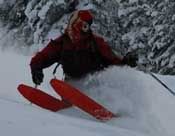flex pattern
Moderators: Head Monkey, kelvin, bigKam, skidesmond, chrismp
-
goneskiing
- Posts: 26
- Joined: Fri Aug 10, 2012 9:25 pm
flex pattern
Hey guys, I'm having some lousy results here with my flex pattern. I'm having my sixth attempt at a solid, backcountry 4 dimensional touring ski. it's got 40 cm early rocker, and the sidecut radius runs about 10 cm up the rocker before narrowing to the tip. The tail is just a standard, low rise tip. My question is, when you guys say that you have something like a profile with 2mm tips, and 11mm underfoot, are you literally just doing one large taper from tip, to underfoot, and back to tail? I suppose it would be self explanatory with a standard sidecut/camber ski, but I'm getting some lousy results here in my flex pattern. Floppy tips and strong camber, strong tips and floppy camber, but never nice and steady throughout. I really don't want to use composites to compensate a lousy core. guess I'm just trying to pick your brains on where you pull your points from and what you keep in mind when designing such core profiles. Thanks guys, anything is much appreciated.
- MontuckyMadman
- Posts: 2395
- Joined: Fri Jun 20, 2008 9:41 pm
a straight line would be referred to as a linear taper.
lots of ways to do a core profile including flat areas under foot as well as in the tip and tail. Splines with change in thickness in the tip and underfoot. depends on the wood species chosen as well. This is the hardest part.
Check out this core profile it sure doent look straight to me.
http://stk.tetongravity.com/forums/atta ... 1360087395
lots of ways to do a core profile including flat areas under foot as well as in the tip and tail. Splines with change in thickness in the tip and underfoot. depends on the wood species chosen as well. This is the hardest part.
Check out this core profile it sure doent look straight to me.
http://stk.tetongravity.com/forums/atta ... 1360087395
sammer wrote: I'm still a tang on top guy.
-
goneskiing
- Posts: 26
- Joined: Fri Aug 10, 2012 9:25 pm
Woah, okay. Thanks. As long as i wasn't just missing some basic equation or something, i don't feel like such a dummy. I spent a lot of hours recently with a scale and a come along, pulling on all the different parts if the skis I've been building, then doing the same with all the major name skis i could get my hands on. Pounds per inch of flex, and then also breaking it down to pounds of force per cm of run throughout the ski. Then input it all in excel and graphed it. turns out i could get about %40 stronger inside my sidecut. It helpef a lot but it's been a frustrating process. Thanks for the input, ill keep having at it!
I use a linear taper from 2.2mm-12-2.3mm. I use the same profile for all my skis. If I want a thinner core, say 11.7 or 11.4 mm waist, I run them through the planer without the sled to cut down the waist. It gives a very small flat spot but I don't think I can feel this.
I occasionally leave the tip thick at about 2.5 mm to leave the transition zones a bit thicker. When i do this I also hand sand the interlock tips with an 80 grit belt to match tip spacer thickness to make sure the base in this area is flat.
If I want to beef up a ski that I think the core is too thin for, an extra layer of triax in the central 1/3 of the ski and/or some extra carbon tow works well.
I occasionally leave the tip thick at about 2.5 mm to leave the transition zones a bit thicker. When i do this I also hand sand the interlock tips with an 80 grit belt to match tip spacer thickness to make sure the base in this area is flat.
If I want to beef up a ski that I think the core is too thin for, an extra layer of triax in the central 1/3 of the ski and/or some extra carbon tow works well.
Fighting gravity on a daily basis
www.Whiteroomcustomskis.com
www.Whiteroomcustomskis.com
-
skidesmond
- Posts: 2338
- Joined: Tue Apr 07, 2009 3:26 pm
- Location: Western Mass, USA
- Contact:

